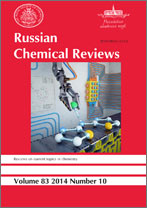|
This article is cited in 4 scientific papers (total in 4 papers)
Principles of the electronic structure of complexes of non-transition elements
G. P. Kostikova, D. V. Korol'kov, Yu. P. Kostikov
St. Petersburg State University, Department of Chemistry
Abstract:
The results of quantum-chemical calculations of electronic structures of complexes of non-transition elements are surveyed. Their X-ray emission and X-ray photoelectron spectra are analysed. General principles of the electronic structure of these complexes are established. It is shown that the effective participation of partially or completely occupied valence npm orbitals of the central atom A of ALk complexes in the formation of delocalised MOs, the negligibly small contribution of vacant And orbitals to the bonds with ligands, the valence inertness or rather low contribution of occupied Ans2 orbitals (except for 2s2 AO) to the valence MOs, and the initiation of the multiple bonds (in the electronic structure of complexes) due to covalent or hypervalent π-interactions involving only 2p (but not 3p, 4p, etc.) atomic orbitals are the most significant factors influencing the electronic structure of non-transition element compounds. The concept of d orbitals and hypervalent bonds is critisised. The bibliography includes 130 references.
Received: 15.04.1996
Citation:
G. P. Kostikova, D. V. Korol'kov, Yu. P. Kostikov, “Principles of the electronic structure of complexes of non-transition elements”, Usp. Khim., 66:4 (1997), 307–327; Russian Chem. Reviews, 66:4 (1997), 281–300
Linking options:
https://www.mathnet.ru/eng/rcr1343https://doi.org/10.1070/RC1997v066n04ABEH000243 https://www.mathnet.ru/eng/rcr/v66/i4/p307
|


| Statistics & downloads: |
| Abstract page: | 105 |
|





 Contact us:
Contact us: Terms of Use
Terms of Use
 Registration to the website
Registration to the website Logotypes
Logotypes








